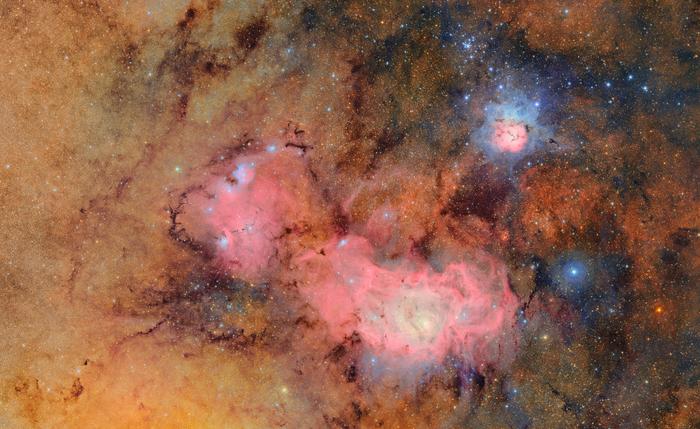The universe has always captivated humanity, and the latest advancements in astronomical technology are poised to deepen our understanding of its vast complexities. The NSF-DOE Vera C. Rubin Observatory in Chile represents a significant leap in our ability to observe and catalog the cosmos. The observatory has recently unveiled its first “mega” images, a remarkable achievement made possible by its state-of-the-art LSST camera. This camera, which is the largest of its kind on the planet, has taken nearly two decades to develop and is the result of collaboration among hundreds of scientists worldwide, including numerous teams from the CNRS in France.
These groundbreaking images were captured in a remarkably short time frame, as the LSST camera collected 678 separate images in just over seven hours. The camera’s extraordinary 3200-megapixel resolution allows it to photograph vast expanses of the sky with unprecedented clarity. Each exposure can cover an area 45 times larger than the full moon, yielding detailed observations of celestial phenomena that are often invisible to smaller telescopes. The unveiling took place during an event at the National Academy of Sciences in Washington, D.C., marking a historic moment in the field of astronomy.
The LSST camera utilizes six different color filters to create images of incredible depth and complexity. Through the integration of these varied exposures, astronomers can discern faint details previously thought undetectable. The latest images prominently feature the Trifid nebula and the Lagoon nebula, both of which are several thousand light-years from Earth. This new capability not only allows us to view these objects in greater detail but also opens the door to discovering new celestial phenomena that have eluded previous observations.
The significance of this technology cannot be overstated. Over the next decade, the Rubin Observatory will execute a monumental ten-year survey of the entire southern sky, capturing 1,000 high-definition photographs every three nights. This effort aims to document subtle changes in the universe, from nearby asteroids and comets to distant supernovae. The survey’s ambitious scale intends to generate a high-definition, four-dimensional “film” of the ever-evolving cosmos, providing a treasure trove of data for researchers worldwide.
As data collection progresses, the impact of the LSST camera on cosmology and our understanding of fundamental questions surrounding dark matter and dark energy will be profound. The final ten years of this project will represent a significant leap forward in our knowledge about the universe’s structure and behavior. Every observation feeds into a comprehensive catalog, effectively building the most detailed repository of cosmic information ever created.
The collaborative nature of this project has brought together institutions and scientists across borders, uniting people with a common goal: to unveil the secrets of the cosmos. The U.S. Department of Energy and the National Science Foundation fund the Rubin Observatory. The SLAC National Accelerator Laboratory played a critical role in constructing the LSST camera, enlisting the expertise of CNRS scientists to assist with its key functionalities, including the design of the focal plane and the development of an automated robotic filter exchange system.
A remarkable amount of data will be generated, with approximately twenty terabytes of information collected each night. In light of this, the France Data Facility (IN2P3) in Lyon will manage and process 40 percent of the raw data generated by the observatory. This immense quantity of data will be shared with the global scientific community at regular intervals, allowing researchers to harness it for a multitude of groundbreaking discoveries in the coming decades.
The Rubin Observatory adds to an already extensive lineage of ground-based telescopes that are essential for comprehensive astronomical exploration. While space-based telescopes have undoubtedly paved the way for several breakthroughs in the field, they remain constrained by limitations in size, sensitivity, and data management. Ground-based observatories, on the other hand, offer unparalleled precision and the ability to continuously improve their equipment. The improvements offered by the LSST camera represent a remarkable evolution in the capabilities of ground-based observation.
In summary, the unveiling of the first “mega” images from the NSF-DOE Vera C. Rubin Observatory marks a transformative moment in the realm of astronomy. With the ambitious goal of capturing the intricacies of the universe over a ten-year period, this state-of-the-art facility has poised itself at the forefront of astronomical research. By unraveling the complexities of the cosmos, the findings from the Rubin Observatory are set to reshuffle our understanding, unveiling new celestial phenomena and shedding light on the fundamental workings of the universe itself. The journey ahead is both exciting and uncertain, but one thing is clear: the more we learn about the cosmos, the more we unveil our own place within this magnificent expanse.
Subject of Research: Astronomical Imaging and Surveys
Article Title: Unveiling the Cosmos: The First Mega Images from the Vera C. Rubin Observatory
News Publication Date: June 23, 2023
Web References: [Link not provided in source material]
References: [Link not provided in source material]
Image Credits: © NSF-DOE Vera C. Rubin Observatory
Keywords
Astronomy, Vera C. Rubin Observatory, LSST Camera, Cosmic Imaging, Dark Matter, Dark Energy, Astrophysics, Nebulae, Celestial Observation, Cosmology




